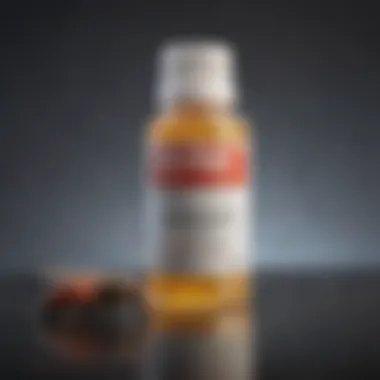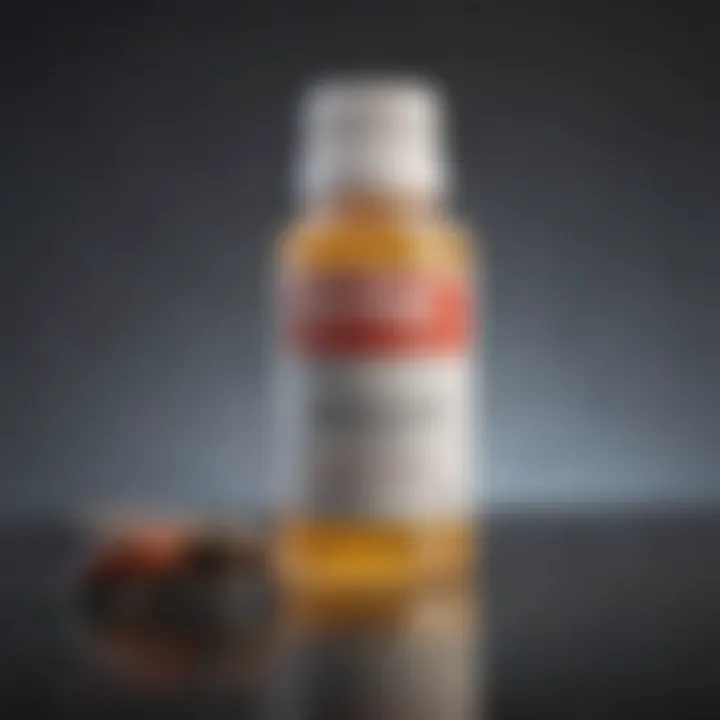Understanding the Temprid Insecticide Label: A Guide


Intro
In today's world, where household pests can wreak havoc on our homes and gardens, understanding the products we use for pest control is paramount. Temprid insecticide stands out among pest management solutions, but its effective use hinges on a thorough comprehension of its label. This guide will walk you through the key components of the Temprid label, offering insights into its active ingredients, dosage recommendations, safety practices, and application methods.
By breaking down the labels into digestible chunks, we aim to arm you with the knowledge you need to tackle invasive pests effectively while prioritizing both safety and environmental health. Let's embark on this journey to demystify the Temprid insecticide label and improve your pest management strategies.
Understanding Pests
Definition of Pests
Pests are typically defined as organisms that cause harm either directly by damaging crops and property or indirectly by spreading diseases. They include insects like ants, roaches, and termites, as well as other creatures such as rodents. The presence of these pests in your home can lead to significant discomfort, damage, or even health risks.
Importance of Pest Identification
Recognizing specific pests is crucial, because not all pesticides are effective against every type of pest. Accurate identification aids in squaring off against the right enemy. Consider this: if you're battling cockroaches, you'll need a different approach compared to leaf-folioing aphids in your garden. Knowing what you’re dealing with can additionally save time and resources, allowing for a more targeted treatment approach.
Importance of the Temprid Insecticide Label
The Temprid label holds essential information that not only describes the product but also provides detailed instructions on its use. Understanding what’s on that label can be the difference between success and failure in keeping your home pest-free. Here are some of the major elements typically presented:
- Active Ingredients: These are the chemical components that kill or repel pests. Knowing their characteristics helps you understand their erosion time and effectiveness.
- Dosage Recommendations: This section provides clarity on how much product to use for optimal results. Using too little may be ineffective, while using too much can be harmful to both humans and pets.
- Application Methods: The method of application can vary significantly, from sprays to granules, and it’s essential to follow these guidelines closely to ensure the safety and efficacy of the treatment.
- Safety Precautions: Here you will find critical information about safe handling to minimize risks to yourself, your family, and your pets.
"A small measure applied incorrectly can lead to consequences that are far-reaching."
The End
Armed with knowledge about pests and how to combat them, you will make more informed decisions concerning pest control in your home. As we proceed through this comprehensive guide, keep in mind that attention to detail and understanding the label of your insecticide can lead not just to a more effective fight against unwanted intruders, but also a healthier living environment for you and your family.
Preface to Temprid Insecticide
Understanding how to effectively manage pest control starts with knowing what products you have in your arsenal. When we talk about Temprid Insecticide, we aren’t just discussing another chemical; we’re diving into a multi-functional solution that promises to tackle a range of household and outdoor pests with remarkable precision.
Temprid is often regarded as a crucial player for both homeowners and pest management professionals alike due to its wide spectrum of action and fast-acting efficacy. Its unique formulation combines two potent active ingredients, giving it the ability to disrupt the nervous system of insects, leading to their quick demise. This isn't just any insecticide—it represents an advance in pest control that balances effectiveness with safety considerations.
While it's tempting to just reach for a spray can when those creepy crawlies start invading our living spaces, having a deeper understanding of Temprid, its ingredients, and its application will empower users to make informed choices. Knowing its specifics can help users avoid common pitfalls that lead to ineffective pest management or, worse, harmful environmental impacts.
Homeowners can greatly benefit from gaining knowledge about the product’s benefits and application methods—no one wants to play a guessing game when it comes to pest control. Additionally, understanding safety measures ensures that families, pets, and the environment are kept out of harm’s way.
"You’ve got to learn to crawl before you can walk."
This saying rings especially true in pest management. By taking the time to understand Temprid Insecticide, readers get a head start in their battle against pests.
In this article, we will dissect the various elements of the Temprid insecticide label, analyze its composition, and offer practical application guidelines and safety tips. Whether you’re a seasoned pest management expert or an enthusiastic homeowner tackling unwanted invaders, a comprehensive grasp on Temprid will ensure you’re well-equipped for success in pest prevention and control.
In summary, this introduction sets the stage for understanding why Temprid is a notable choice in the realm of insecticides. With a good grip on its features, users will be more capable of securing their spaces against unwelcome pests.
The Composition of Temprid
Understanding the composition of Temprid insecticide is paramount for recognizing how it works and how to effectively utilize it in pest management. This section dives into the intricate details of both the active and inert ingredients that constitute Temprid. Comprehending these particulars not only enhances the effectiveness of the product but also ensures safety when applying it in various environments.
Active Ingredients
The active ingredients present in an insecticide are the main components responsible for its pest control efficacy. For Temprid, two key ingredients stand out: Imidacloprid and Beta-Cyfluthrin. Both play substantial roles in attacking targeted pests while also providing a unique balance of immediate and residual effects.
Imidacloprid
Imidacloprid is a synthetic neonicotinoid that acts on the nervous system of insects. One significant characteristic of Imidacloprid is its toxicity to pests while being relatively safe for humans and pets when used according to label instructions. This selectivity is a definitive benefit, as it minimizes risks to non-target organisms.
A unique feature of Imidacloprid is its systemic action, which means it can be absorbed by plants and affect insects that feed on them as well, widening its scope of effectiveness. In terms of advantages, it has proven effective against various pests such as ants and cockroaches, enhancing Temprid's reliability. However, there are some disadvantages to consider, such as the potential for resistance if not used with other management strategies.
Beta-Cyfluthrin
Beta-Cyfluthrin, on the other hand, is a pyrethroid that mimics the effects of naturally occurring pyrethrins. Its key characteristic lies in its ability to achieve rapid knockdown of pests through contact and ingestion. This fast action makes it extremely useful for immediate pest problems, and its residual properties offer lasting protection even after application.
A unique feature is that Beta-Cyfluthrin is particularly effective against a broad range of insects, including spiders and beetles. Its advantages include versatility and relatively low toxicity to mammals, making it a favored choice in residential settings. Nevertheless, when overused, there's a chance of disadvantages, such as susceptibility of pests to develop resistance, which prompts the need for rotation with other active ingredients.
Inert Ingredients
Beyond active ingredients, inert components also form an essential part of the formula. While they do not kill pests directly, inert ingredients help enhance the performance and stability of Temprid.
Role and Function
Inert ingredients serve multiple purposes in Temprid. They act as carriers, aiding in the delivery of active ingredients to targeted pests. This functional aspect ensures that the insecticide remains effective even under varying environmental conditions. Their presence can improve product stability and prevent the active ingredients from degrading prematurely, leading to improved shelf life and efficacy.
The unique feature of these inert substances is that they can include surfactants or emulsifiers, which help enhance the spreading and sticking properties of the formulation. However, one must be cautious; depending on their composition, some inert ingredients may pose environmental concerns, particularly around aquatic systems or non-target organisms.
Chemical Profiles
Chemical profiles of inert ingredients shed light on why certain compounds are selected for formulations. A detailed understanding of these profiles can help users comprehend potential safety risks associated with the product. These profiles typically encompass aspects like toxicity levels, environmental fate, and even effects on application safety.


The characteristic of inert ingredients is that they often have extensive testing data to assess their safety and compatibility with active components. For a product like Temprid, these profiles bolster consumer confidence as they demonstrate safety to human health and the environment.
While inert ingredients enhance functionality, the involvement of any potentially hazardous chemicals could require consumers to scrutinize product labels closely. By fostering awareness about both active and inert components of Temprid insecticide, homeowners and pest control professionals can utilize this knowledge for responsible and effective pest management.
Deciphering the Label
Understanding the label of any insecticide is paramount, and Temprid is no different. Reading and interpreting the label correctly allows users to make informed decisions about how best to apply the product safely and efficiently. This knowledge not only ensures the effectiveness of the treatment but also plays a critical role in protecting both user health and the environment.
Key Elements of the Label
The Temprid label is designed to provide vital information to help its users navigate the complexities of pest control. It includes several sections that guide users through safety measures, application methods, recommended dosages, and target pests.
- Active Ingredients: The label clearly lists the active ingredients, allowing users to understand what chemicals they are handling. Knowing if it contains Imidacloprid or Beta-Cyfluthrin can affect how one interacts with the product.
- Usage Instructions: These instructions provide specifics on how to mix and apply the insecticide effectively. They outline preparation techniques and help avoid potential mistakes that could undermine the pesticide's performance.
- Safety Precautions: A critical section for novice and seasoned users alike, safety precautions ensure that appropriate measures are taken to minimize health risks when using the product. This part often specifies the personal protective equipment (PPE) required, from gloves and goggles to respirators, establishing a baseline for safe handling.
- Application Timing and Frequency: Understanding when and how often to apply Temprid is essential for achieving desired results. The label often recommends specific timings, helping users strategize pest control plans effectively.
- Environmental Impact: This section discusses considerations about non-target species and general environmental safety, prompting users to think before they spray.
Benefits of Understanding the Label
Being able to decipher the Temprid label leads to several tangible benefits:
- Enhanced Efficacy: Misapplication can mean the difference between effective pest control and a wasted effort. Proper understanding improves the odds of a successful treatment.
- Safety: Knowledge of how to use the product safely reduces the risk of accidents or exposure to harmful chemicals.
- Cost Efficiency: By following the guidelines properly, users can avoid unnecessary repurchases of the product or additional treatments due to mishaps.
"A well-read label can transform a frustrating pest problem into a manageable one."
Considerations
When working with the Temprid label, consider the following:
- Updates: Always check for the latest version of the label, as manufacturers may update their instructions or safety precautions periodically.
- Local Regulations: Be aware that certain areas may have specific regulations governing pesticide use, adding another layer of consideration when interpreting the label.
End
In summary, deciphering the Temprid insecticide label is not merely a task; it's the cornerstone of effective pest management. Understanding the intricacies of the label can empower users to apply the insecticide correctly, safely, and responsibly, leading to a pest-free environment that benefits everyone.
Application Guidelines
In any pest control regimen, the application guidelines are the bread and butter of effective insecticide use. The way you mix, apply, and determine the frequency can significantly dictate the outcomes of your pest management efforts. With Temprid insecticide, understanding the application guidelines helps both seasoned users and novices alike achieve optimal results while protecting themselves and their environment.
How to Prepare the Mixture
Recommended Ratios
When it comes to the recommended ratios for mixing Temprid, precision isn’t just recommended; it’s paramount. The correct ratio between the insecticide and water can make all the difference between an effective treatment and an ineffective one that leaves pests munching away. Generally, a common practice is to mix about 0.5 to 1 ounce of Temprid per gallon of water. This guideline is favored due to its balance; it’s potent yet remains friendly to non-target species.
However, keep in mind that tailoring this ratio to specific pest problems may yield better results. If you're treating a severe infestation, you might find increasing the concentration beneficial—but tread lightly, as over-concentration can lead to resistance build-up in pests.
Mixing Techniques
The success of pest control largely hinges on how well you mix Temprid. One popular option among users is the two-container technique: one for the concentrate and another for water. This allows for an even distribution when combined. Fill the water container halfway, add the concentrate, and stir gently to avoid foaming. This method is particularly praised for achieving a smooth, effective solution.
As a unique feature, using warm water can help dissolve the insecticide better if you're in colder regions. However, be cautious with this; hot enough water may degrade some of the chemical properties. Proper mixing ensures that the active ingredients are suspended correctly, ensuring a consistent application across the board.
Proper Application Techniques
Target Areas
Identifying your target areas for application is crucial—it’s where the effectiveness can shine or fall flat. Focus on hotspots where pests typically gather, like kitchens for roaches or corners in bathrooms for spiders. This targeted approach maximizes contact with the insect, making it a preferred choice for homeowners facing various infestations.
A key aspect of focusing on target areas is that it minimizes waste. Applying the mixture exactly where pests tend to hang out prevents unnecessary exposure to non-target areas and reduces environmental impact.
Equipment Needed
The right equipment can enhance the ease and efficiency of your application process. A hand-held sprayer is usually the pick of the litter for most homeowners. It allows for precise application without excessive overspray. Booster backpacks are also an option for larger areas, providing the benefit of mobility.
Consider also wearing gear like goggles and gloves to keep yourself safe. These simple precautions help in making the process smoother while ensuring you don’t compromise your health while tackling pesky critters.
Frequency of Application
Initial Treatment
Here, the importance of an initial treatment cannot be overstated. It sets the stage for the following interactions with pests. Most users will employ Temprid in a targeted manner, applying it directly to areas with heavy pest activity. An immediate result can often be observed within hours, providing a sense of relief. This initial treatment is critical as it kicks off the pest-control cycle, driving down visible pest numbers efficiently.
Follow-Up Treatments
After an initial treatment, follow-up applications are necessary to maintain the pressure on any lurking pests. Depending on the type of infestation, follow-up treatments might happen every two to three weeks. This regularity is a double-edged sword though; doing it too often can lead to resistance, while too infrequent might allow pesky critters to rebound. The trick, as always, lies in striking the right balance between persistence and restraint.
Safety Precautions
When dealing with insecticides like Temprid, safety isn’t just a protocol; it’s a non-negotiable aspect of the process. You wouldn’t jump into a pool without checking the water first, right? Similarly, understanding and implementing safety precautions can help prevent mishaps that may arise from careless handling or application.
By ensuring safety measures are in place, not only do you protect yourself, but also safeguard your environment. This includes minimizing the risk of exposure to harmful chemicals not only for yourself but also for pets, children, and surrounding wildlife. Knowing the relevant safety practices before you reach for the spray can give peace of mind while making your home pest-free.


Personal Protective Equipment
Gloves
The use of gloves when applying Temprid is essential. These personal protective devices act as your first line of defense against direct skin contact with the insecticide. Not all gloves are crafted alike, so one key characteristic to look for is their material. Nitrile gloves, for instance, are a common choice, as they offer chemical resistance and provide a snug fit, allowing for better handling of application equipment.
Their unique feature lies in their durability; unlike latex gloves which can be prone to tearing, nitrile can withstand varied conditions, which is a big plus during pest management tasks. However, be mindful of the fit; ill-fitting gloves can reduce dexterity and may even increase the risk of accidental spills if you lose your grip.
Respirators
Respirators serve a different but equally critical purpose. They filter out harmful vapors that you might inhale during application. This type of equipment is often overlooked by casual users, making it a noteworthy recommendation in the realm of safe pesticide use. A key characteristic of respirators is their filtration capabilities, which directly contributes to the overall safety of the application process.
A significant advantage of using a respirator is its potential to substantially reduce inhalation exposure to toxic fumes, particularly beneficial when treating larger indoor areas or outdoor spaces. However, it’s essential to ensure that the respirator fits properly. An ill-fitted respirator could offer a false sense of security while leaving you vulnerable. Confirming the correct type of respirator and fittings makes for a safer work environment.
Environmental Considerations
Impact on Non-Target Species
One of the most crucial aspects to consider is the impact on non-target species. When applying Temprid, you aim to eliminate unwanted pests, but it's essential to recognize that some of these applications could inadvertently affect beneficial insects like bees and butterflies. This unintended consequence underscores the importance of precise application techniques and timing.
The key characteristic here is specificity; using targeted application methods—like spot treatments instead of blanket spraying—can significantly lessen the effect on non-target species. It’s of utmost importance to read the label and understand when and where to apply to reduce this risk. This understanding not only promotes responsible pest management but also preserves the ecological balance in your surroundings.
Water Safety
Another consideration is water safety. When applying Temprid, you want to keep in mind the proximity of water sources—think ponds, streams, or even your garden hoses. Water safety is about ensuring that no harmful chemicals seep or wash into these resources, which could have far-reaching consequences for aquatic life.
A beneficial aspect of considering water safety is that it encourages careful planning. Marking a buffer zone around water bodies during application reduces the risk of contamination. Remember that water safety isn’t merely about following the product label; it’s also about being a conscious steward of your local environment.
"The careful use of insecticides is not just about pest control, but about protecting our environment for future generations."
In summary, adhering to the safety precautions laid out when using Temprid significantly enhances both your own safety and that of the environment. Taking the time to use the right personal protective equipment and being mindful of ecological impacts can ensure that pest management practices are as responsible as they are effective.
Target Pests
Understanding the target pests is crucial when using Temprid insecticide. Target pests not only influence the effectiveness of the application but also determine how to best approach pest management in and around your home. Each pest type has its own behaviors and vulnerabilities, making certain insecticides, like Temprid, particularly suited for specific situations.
Common Household Pests
Household pests tend to invade spaces where people live, leading to discomfort and potential health issues. Understanding them can help in utilizing Temprid effectively to maintain a pest-free environment.
Ants
Ants are often considered the most common culprits in many households. They’re social insects, foraging in large groups, which can make them seem overwhelming when they invade. Their ability to create a colony nearby makes them a persistent problem. Using Temprid effectively targets their trails and nests. A notable characteristic of ants is their ability to communicate and share food with one another, which means that a single spray can affect many individuals and their colony. However, care must be taken, as not all species respond equally, and some might develop resistance.
Roaches
Roaches are another notorious household pest. Their presence often evokes disgust, and they can carry diseases that affect human health. One key feature that sets roaches apart is their ability to thrive in various conditions, making them particularly challenging to eliminate. Temprid's formulation begins working quickly, providing both immediate and long-lasting effects, which is a major advantage when fighting these resilient intruders. Even though they tend to hide, a well-targeted spray can effectively reach them in their primary habitats.
Spiders
Spiders might not be a traditional pest to some, but they can be quite a nuisance, especially if they set up shop in corners of your home. While they can actually help control other pest populations, excessive spider presence might cause discomfort for homeowners. The unique characteristic of spiders is their web-making ability; thus, treating areas where they build webs can effectively reduce their numbers. Temprid's wide reach can help deal with various spider species and can deter them from returning, giving a more comfortable space for everyone.
Outdoor Pests
Outdoor pests are those pesky critters that tend to congregate in gardens and landscapes, causing a range of issues, from damage to plants to irritation.
Landscape Pests
Landscape pests typically include insects that harm the aesthetic appeal and health of plants in your yard. Whether it’s aphids suckling on leaves or beetles munching on flowers, these pests can wreak havoc. One key advantage of recognizing landscape pests is that early identification can make treatment more effective. Temprid's action quickly approaches these invaders, reducing the risk of extensive damage. Its broad-spectrum effectiveness allows it to target several types of landscape pests without needing multiple products, simplifying the homeowner's pest management strategy.
Garden Pests
Garden pests can devastate a variety of vegetables, fruits, and ornamental plants. Common offenders include caterpillars and weevils that can quickly decimate a garden. By understanding these pests and their behavior, homeowners can better utilize Temprid to protect their plants. Its ability to provide both quick knockdown and prolonged residual effects ensures that it offers protection not just for the moment, but for times when pests could re-infest. However, some garden-friendly insects may also be targeted, warranting careful application to ensure beneficial organisms remain unharmed.
"Knowing your pests can mean the difference between a flourishing garden and a failed attempt at pest control."
By having a handle on both household pests and outdoor predators, homeowners gain more control over their living spaces. The knowledge not only leads to effective treatments but also aids in preventative measures that keep invasions at bay.
Efficacy and Performance
When dealing with pest control, the terms efficacy and performance take center stage. They play a pivotal role in determining how effective a product like Temprid will be in managing pest populations. Knowing how quickly a product acts and how long it remains effective in the environment is essential for homeowners who want to maintain a pest-free space without constant reapplication.
Speed of Action
One of the first considerations to think about in the context of pest control is speed of action, which can best be understood through two concepts: immediate effects and residual effects.
Immediate Effects


This refers to how quickly the insecticide takes action after application. When Temprid is sprayed, you can visibly notice the results within a short time. The key characteristic here is its rapid knockdown capability, which is immensely beneficial for a household facing a sudden infestation.
This immediate impact can calm those nagging worries of pests invading living spaces. Importantly, it's not just about speed; it’s about efficiency in eliminating pests that can ruin one's day.
However, while immediate effects are generally seen as an advantage, they are not without their caveats. Some may argue that quick kill times could lead to a false sense of security, making homeowners think they don’t need to monitor for further infestations.
Residual Effects
After that initial shock of the immediate effects comes the residual effects of the insecticide. This aspect deals with how long the product continues to keep pests at bay. Temprid's formula offers a significant lasting impact, which is invaluable for both homeowners and professionals alike.
With a key characteristic of providing extended protection, it reduces the frequency at which reapplications are necessary. This long-lasting effect makes it a popular choice among many dealing with ongoing pest problems, saving not just time but also money in the long run.
Nonetheless, while beneficial, the unique feature of residual effects also requires careful attention. Improper application or environmental conditions could diminish efficacy over time, leading to possible resistance in targeted pests.
Resistance Management
Next on the list is resistance management, an important issue in pest control. A deeper understanding of resistance dynamics directly influences the effectiveness of a product like Temprid.
Understanding Resistance
When we discuss resistance, we’re talking about the ability of pest populations to survive despite exposure to insecticides. Grasping this concept is crucial, especially for home users who want to ensure the longevity of an effective pest control strategy.
The key characteristic here is adaptation; pests can change over time in response to the insecticide. Recognizing this natural process makes a strong case for varying application methods and products. Those who stay aware of this dynamic can improve their pest management outcomes, leading to a sustainable pest control environment in their homes.
However, a drawback of understanding resistance is that it can overwhelm some users. It's vital to remember that the knowledge gained should lead to informed decisions rather than create unnecessary anxiety about pest control.
Best Practices
Establishing best practices is essential to minimize resistance. Homeowners should rotate products with different modes of action, helping to keep pests guessing and less likely to develop resistance.
Focusing on a key characteristic of integrated pest management can lead to remarkable reductions in pest populations. For example, mixing biological controls with chemical applications can enhance overall effectiveness.
On the flip side, not adhering to these practices can lead to high pest populations resistant to treatment options. This is why it is crucial to stay informed and proactive in pest management, understanding that the methods used today will likely affect efficacy in the future.
"Ultimately, sound pest management goes beyond just applying a product. It’s about understanding the broader picture, including pest behavior and environmental factors."
As you proceed with utilizing Temprid and managing pests, keep these insights firmly in mind, as they can make a world of difference in your pest control efforts.
Additional Considerations
In any conversation about pest control, additional considerations often slip through the cracks. Yet, they can make a world of difference in achieving optimal results with Temprid insecticide. From the appropriate storage methods to understanding regulatory aspects, these details play a crucial role in ensuring both efficacy and safety. Homeowners must feather their caps with a robust understanding of how to handle this product and what legalities come into play. The right approach not only protects one's family and pets but also contributes to the health of the environment. In this section, we’ll delve into these aspects, threading through the specifics that may not immediately catch the eye.
Storing Temprid Safely
Storage Conditions
When it comes to storing Temprid, conditions are everything. Proper storage ensures that the product maintains its integrity and efficacy over time. Ideally, Temprid should be kept in a cool, dry place away from direct sunlight. This is not just a concern for the insecticide's effectiveness; it’s also about safety. Excessive heat or moisture can lead to degradation of the active ingredients, which in turn diminishes its capacity to tackle those pesky intruders.
A significant detail is that storage must be locked and inaccessible to children and pets. This protective measure emphasizes the importance of safety while keeping your home pest-free. Not only does this prevent potential accidents, but it also ensures that the insecticide retains its potency when it's finally needed. For instance, stashing the container in a sealable bin provides additional safeguards against inhalation of fumes or spills, ensuring a worry-free storage environment.
Disposal Methods
Proper disposal of Temprid is an oft-overlooked yet integral part of responsible pest control. Simply tossing the container or leftover insecticide in the trash is not an option. Instead, homeowners are encouraged to consult local waste management regulations to determine the most appropriate disposal methods in their area. Many municipalities offer special collection days for hazardous materials, making it easier to dispose of such products safely.
One of the standout features of responsible disposal is the call for minimizing environmental impact. Returning unused pesticides to a retailer who has waste disposal programs can ensure they do not end up in landfill or waterways, protecting local ecosystems from contamination. By following these guidelines, homeowners not only comply with regulations but also play an active role in safeguarding their communities.
Legal Restrictions and Regulations
Registered Uses
Understanding the registered uses of Temprid is paramount for anyone looking to use this insecticide effectively and legally. Each state may have different guidelines regarding where and how Temprid can be applied. Familiarity with these restrictions not only prevents potential fines or legal issues but also enhances safety in your pest control practices. Failure to adhere to these registered uses can lead to ineffective pest control, or worse, harm to beneficial insects or the environment.
For example, while Temprid is effective for indoor pests, there may be specific limitations on outdoor usage in certain areas. Notably, some regions may restrict its application during certain seasons or under specific weather conditions—an aspect that savvy homeowners should keep in mind to ensure both legality and efficacy. Understanding and following these guidelines means that each spray or treatment can be counted on to work as intended.
State Regulations
Diving into state regulations requires a bit of homework but pays off beautifully when it comes to applying Temprid lawfully. These regulations can be quite specific and change from year to year. Thus, it’s essential to stay updated on state-level guidelines that dictate the conditions under which Temprid can be used.
Many states require notification to neighbors when pesticides are applied, particularly in densely populated areas. This requirement serves as a layer of transparency, promoting community awareness regarding pest control activities. Homeowners could also find differing regulations about frequency and method of application. By absorbing this legal knowledge, one can navigate the complex world of pest control while fostering healthy and eco-friendly environments—truly a win-win situation.
In summary, as you embark on your pest control journey with Temprid, remember that additional considerations are not just side notes; they are essential facets that contribute to effective pest management and compliance with the law. Keeping your storage practices in check and following through with disposal and regulatory guidelines is key to skillfully wielding this powerful tool against household pests.
The End
The conclusion of this guide serves as a vital component, tying together all the aspects discussed throughout the article. Understanding the Temprid insecticide label is not just about knowing how to apply a product; it's about grasping the profound implications behind each detail presented on that label. Here's why it matters:
First off, comprehension of the active ingredients within Temprid allows users to make informed decisions on how best to handle pest issues. Being familiar with components like Imidacloprid and Beta-Cyfluthrin can aid in understanding how they interact with various pests, thus improving effectiveness.
Secondly, knowing the application guidelines ensures that the product is used safely and appropriately. This prevents misuse, which can lead to both ineffective pest control and potential hazards to health and the environment. For instance, adhering to the recommended mixing ratios helps maintain the potency of the solution while minimizing any adverse effects.
Moreover, the safety precautions highlight the importance of protecting oneself and the surroundings during application. Personal protective equipment like gloves and respirators aren't just suggestions; they are critical measures to safeguard against potential risks. Recognizing this can make all the difference when managing pests effectively.
Lastly, being aware of target pests and the expected efficacy is crucial for a successful pest management strategy. Homeowners can save time and resources by targeting the right pests effectively with the information gathered from the label.
In summary, the conclusion emphasizes the synergy of knowledge and responsible usage in pest management. It empowers readers to take control of their pest issues with confidence, knowing they are well-informed and equipped to handle the situation effectively. By respecting the instructions and safety guidelines, homeowners can protect their space without compromising health or environmental standards. > Ultimately, the Temprid insecticide label stands as a comprehensive source of wisdom for both experienced users and novices alike, enhancing the overall approach to household pest management.



